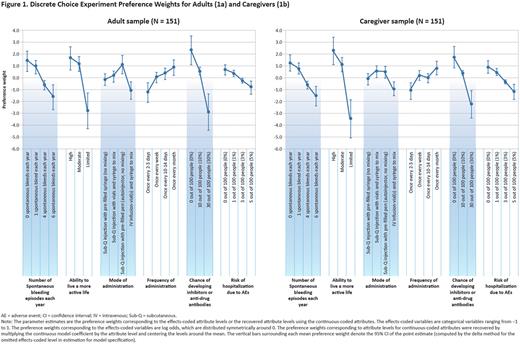Abstract
Background: The treatment landscape for hemophilia is evolving. Hence it is important to understand how people with hemophilia and their caregivers value attributes of existing and novel prophylactic treatments. A discrete-choice experiment (DCE) was used to quantify preferences for features of hemophilia treatments among adults and caregivers of children with hemophilia in the US.
Methods: A cross-sectional, web-based DCE survey was administered to male adults (≥18 years) and caregivers of male children (≤17 years) living with hemophilia in the US. Respondents evaluated 8 pairs of hypothetical hemophilia treatment profiles defined by 6 attributes - number of annual spontaneous bleeding episodes, lifestyle benefits from improvement in function, route of administration, frequency of administration, risk of developing inhibitors or anti-drug antibodies, and risk of hospitalization due to adverse events (AEs). Attributes for the DCE were informed by a literature review and ranking exercise among adult patients, caregivers, physicians, and stakeholders. The DCE data were analyzed using a random parameters logit (RPL) model and used to calculate the maximum acceptable risk (MAR) of AEs respondents were willing to accept for specific improvements in other study attribute levels. MAR is calculated as the point where the disutility of an increase in risk balances the utility associated with an improvement in a treatment attribute.
Results: The final sample included 151 adults (average age 40 years) and 151 caregivers (average age 38 years old, 92% female). For the adult sample, avoiding a 30% risk of developing inhibitors or anti-drug antibodies had the greatest relative importance, followed by improving the ability to live a more active life from limited to high, reducing the number of spontaneous bleeding episodes each year from 6 to 0, change in mode of administration from an intravenous (IV) with vial(s) and syringe to mix to a subcutaneous (Sub-Q) injection with pre-filled pen, reducing frequency of administration from once every 2-3 days to once a month, and avoiding a 5% risk of hospitalization due to AEs (Figure 1a). For caregivers, improving the ability to live a more active life from limited to high had the greatest relative importance, followed by avoiding a 30% risk of developing inhibitors or anti-drug antibodies, reducing the number of spontaneous bleeding episodes each year from 6 to 0 annual bleeds, avoiding a 5% risk of hospitalization due to AEs, reducing frequency of administration from once every 2-3 days to once a month, and a change in mode of administration from an IV with vial(s) and syringe to mix to a Sub-Q injection with vial(s) and syringe to mix (Figure 1b). In general, adults and caregivers preferred treatments that needed to be taken less frequently (e.g., once a month compared with every 2-3 days). Adults preferred a Sub-Q injection with a pre-filled pen compared with other routes of administration. Caregivers preferred Sub-Q options to an IV. Looking at the MAR results, caregivers were willing to accept higher risks of developing inhibitors or anti-drug antibodies than adults for improvements in other attributes. Caregivers were willing to accept a risk of developing inhibitors or anti-drug antibodies greater than 30% for an improvement in the ability to live a more active life from limited to high and 21% for a reduction in the number of spontaneous bleeding episodes each year from 6 to 0, compared to 26% and 17% for adults, respectively. Both groups were willing to accept similar levels of risk of hospitalization due to AEs for improvements in other attributes, accepting greater than 5% for improvements in the ability to live a more active life from limited to moderate or high and for a reduction in the number of spontaneous bleeding episodes each year from 6 to either 1 or 0 spontaneous bleeds.
Conclusion: Patients and caregivers prefer treatments that enable more active lifestyle with lower risk of inhibitor development. Both groups valued the ability to lead an active life even over reducing spontaneous bleeding, with caregivers placing the most weight on this attribute suggesting that with the changing landscape in hemophilia treatments, patients and caregivers are willing to trade off benefits and risks of hemophilia treatments. These findings highlight the need for healthcare professionals and patients to share decision making based on clinical judgement and individual preferences.
Disclosures
Cano:Sanofi: Current Employment, Current holder of stock options in a privately-held company. Mansfield:RTI Health Solutions: Current Employment, Other: I am a full time employee of Research Triangle Institute d/b/a RTI Health Solutions. The research that is the subject of this abstract was performed in the course of my employment, pursuant to a contract between my employer and the study sponsor.. Pierce:RTI Health Solutions: Current Employment, Other: I am a full time employee of Research Triangle Institute d/b/a RTI Health Solutions. The research that is the subject of this abstract was performed in the course of my employment, pursuant to a contract between my employer and the study sponsor.. Leach:RTI Health Solutions: Current Employment, Other: I am a full time employee of Research Triangle Institute d/b/a RTI Health Solutions. The research that is the subject of this abstract was performed in the course of my employment, pursuant to a contract between my employer and the study sponsor.. Cavanaugh Smith:Sanofi: Current Employment, Current holder of stock options in a privately-held company. DasMahapatra:Sanofi: Current Employment, Current holder of stock options in a privately-held company. Bartelt-Hofer:Sanofi: Current Employment, Current holder of stock options in a privately-held company.
Author notes
Asterisk with author names denotes non-ASH members.


This feature is available to Subscribers Only
Sign In or Create an Account Close Modal